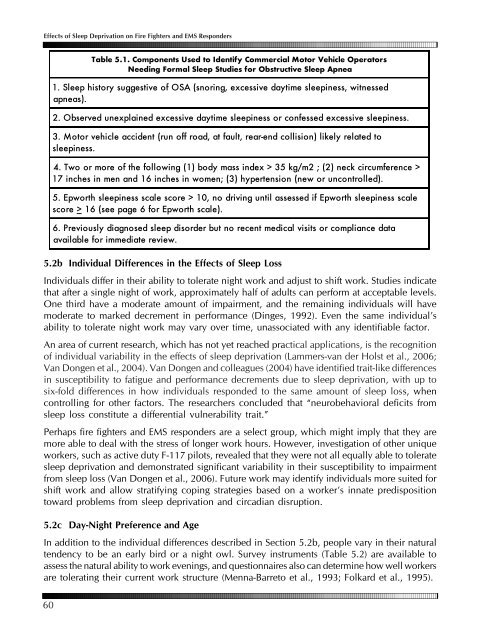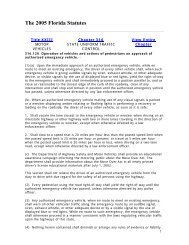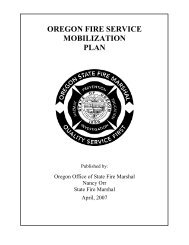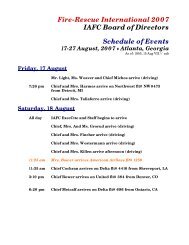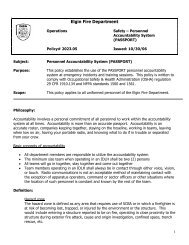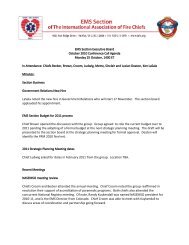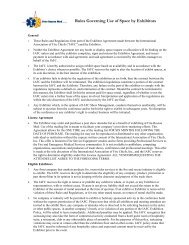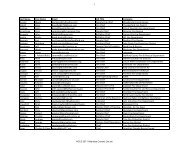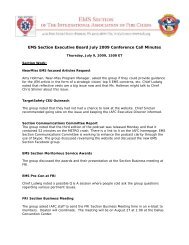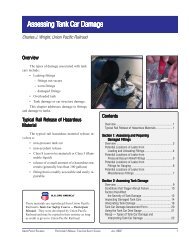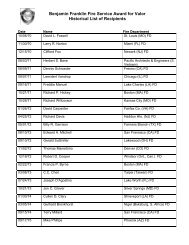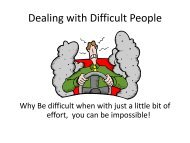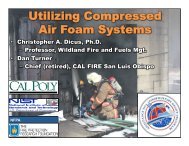Effects of Sleep Deprivation on Fire Fighters and EMS ... - NAEMT
Effects of Sleep Deprivation on Fire Fighters and EMS ... - NAEMT
Effects of Sleep Deprivation on Fire Fighters and EMS ... - NAEMT
Create successful ePaper yourself
Turn your PDF publications into a flip-book with our unique Google optimized e-Paper software.
<str<strong>on</strong>g>Effects</str<strong>on</strong>g> <str<strong>on</strong>g>of</str<strong>on</strong>g> <str<strong>on</strong>g>Sleep</str<strong>on</strong>g> <str<strong>on</strong>g>Deprivati<strong>on</strong></str<strong>on</strong>g> <strong>on</strong> <strong>Fire</strong> <strong>Fighters</strong> <strong>and</strong> <strong>EMS</strong> Resp<strong>on</strong>ders<br />
Table 5.1. Comp<strong>on</strong>ents Used to Identify Commercial Motor Vehicle Operators<br />
Needing Formal <str<strong>on</strong>g>Sleep</str<strong>on</strong>g> Studies for Obstructive <str<strong>on</strong>g>Sleep</str<strong>on</strong>g> Apnea<br />
1. <str<strong>on</strong>g>Sleep</str<strong>on</strong>g> history suggestive <str<strong>on</strong>g>of</str<strong>on</strong>g> OSA (snoring, excessive daytime sleepiness, witnessed<br />
apneas).<br />
2. Observed unexplained excessive daytime sleepiness or c<strong>on</strong>fessed excessive sleepiness.<br />
3. Motor vehicle accident (run <str<strong>on</strong>g>of</str<strong>on</strong>g>f road, at fault, rear-end collisi<strong>on</strong>) likely related to<br />
sleepiness.<br />
4. Two or more <str<strong>on</strong>g>of</str<strong>on</strong>g> the following (1) body mass index > 35 kg/m2 ; (2) neck circumference ><br />
17 inches in men <strong>and</strong> 16 inches in women; (3) hypertensi<strong>on</strong> (new or unc<strong>on</strong>trolled).<br />
5. Epworth sleepiness scale score > 10, no driving until assessed if Epworth sleepiness scale<br />
score > 16 (see page 6 for Epworth scale).<br />
6. Previously diagnosed sleep disorder but no recent medical visits or compliance data<br />
available for immediate review.<br />
5.2b Individual Differences in the <str<strong>on</strong>g>Effects</str<strong>on</strong>g> <str<strong>on</strong>g>of</str<strong>on</strong>g> <str<strong>on</strong>g>Sleep</str<strong>on</strong>g> Loss<br />
Individuals differ in their ability to tolerate night work <strong>and</strong> adjust to shift work. Studies indicate<br />
that after a single night <str<strong>on</strong>g>of</str<strong>on</strong>g> work, approximately half <str<strong>on</strong>g>of</str<strong>on</strong>g> adults can perform at acceptable levels.<br />
One third have a moderate amount <str<strong>on</strong>g>of</str<strong>on</strong>g> impairment, <strong>and</strong> the remaining individuals will have<br />
moderate to marked decrement in performance (Dinges, 1992). Even the same individual’s<br />
ability to tolerate night work may vary over time, unassociated with any identifiable factor.<br />
An area <str<strong>on</strong>g>of</str<strong>on</strong>g> current research, which has not yet reached practical applicati<strong>on</strong>s, is the recogniti<strong>on</strong><br />
<str<strong>on</strong>g>of</str<strong>on</strong>g> individual variability in the effects <str<strong>on</strong>g>of</str<strong>on</strong>g> sleep deprivati<strong>on</strong> (Lammers-van der Holst et al., 2006;<br />
Van D<strong>on</strong>gen et al., 2004). Van D<strong>on</strong>gen <strong>and</strong> colleagues (2004) have identified trait-like differences<br />
in susceptibility to fatigue <strong>and</strong> performance decrements due to sleep deprivati<strong>on</strong>, with up to<br />
six-fold differences in how individuals resp<strong>on</strong>ded to the same amount <str<strong>on</strong>g>of</str<strong>on</strong>g> sleep loss, when<br />
c<strong>on</strong>trolling for other factors. The researchers c<strong>on</strong>cluded that “neurobehavioral deficits from<br />
sleep loss c<strong>on</strong>stitute a differential vulnerability trait.”<br />
Perhaps fire fighters <strong>and</strong> <strong>EMS</strong> resp<strong>on</strong>ders are a select group, which might imply that they are<br />
more able to deal with the stress <str<strong>on</strong>g>of</str<strong>on</strong>g> l<strong>on</strong>ger work hours. However, investigati<strong>on</strong> <str<strong>on</strong>g>of</str<strong>on</strong>g> other unique<br />
workers, such as active duty F-117 pilots, revealed that they were not all equally able to tolerate<br />
sleep deprivati<strong>on</strong> <strong>and</strong> dem<strong>on</strong>strated significant variability in their susceptibility to impairment<br />
from sleep loss (Van D<strong>on</strong>gen et al., 2006). Future work may identify individuals more suited for<br />
shift work <strong>and</strong> allow stratifying coping strategies based <strong>on</strong> a worker’s innate predispositi<strong>on</strong><br />
toward problems from sleep deprivati<strong>on</strong> <strong>and</strong> circadian disrupti<strong>on</strong>.<br />
5.2c Day-Night Preference <strong>and</strong> Age<br />
In additi<strong>on</strong> to the individual differences described in Secti<strong>on</strong> 5.2b, people vary in their natural<br />
tendency to be an early bird or a night owl. Survey instruments (Table 5.2) are available to<br />
assess the natural ability to work evenings, <strong>and</strong> questi<strong>on</strong>naires also can determine how well workers<br />
are tolerating their current work structure (Menna-Barreto et al., 1993; Folkard et al., 1995).<br />
60


